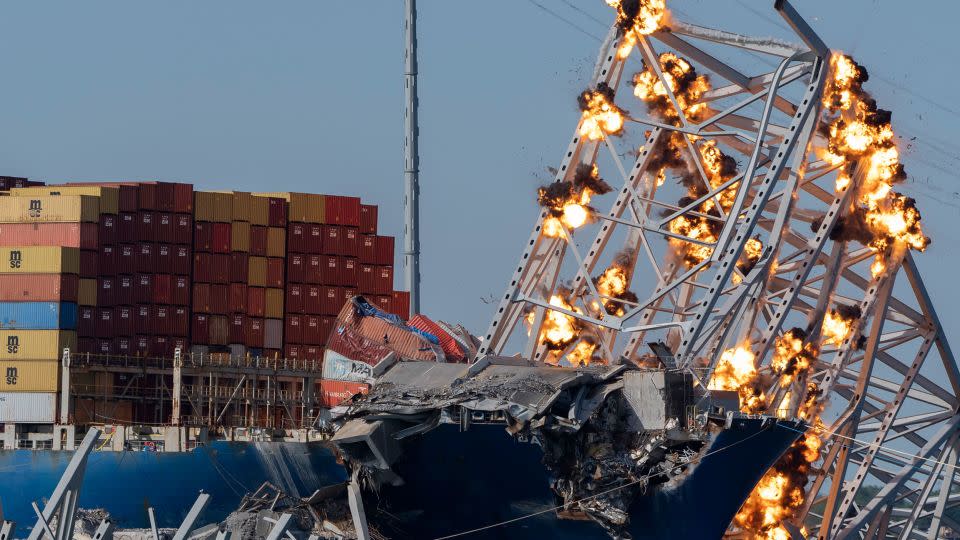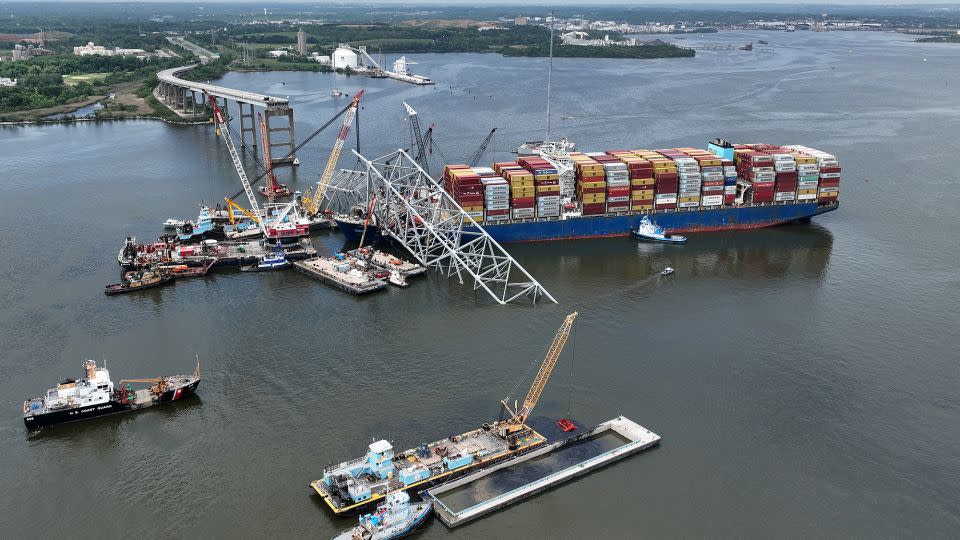Cargo ship will ‘hopefully’ be refloated this week after explosives remove some Baltimore bridge wreckage from vessel
The trapped cargo ship Dali will “hopefully” be refloated this week after authorities set off charges at a key portion of the collapsed Francis Scott Key Bridge in Baltimore on Monday evening, an official said.
The charges helped demolish a portion of the bridge wreckage that was resting on the ship – a move meant to help free the vessel, nearly seven weeks after it struck the bridge and caused the span to collapse. During the planned detonation, a chunk of the collapsed structure appeared to fall away from the ship and into the water, though a portion of wreckage remained on top of the ship, video showed.
Officials are “very pleased” with the demolition but will be conducting surveys with divers to make sure nothing fell and damaged the hull of the cargo vessel, US Army Corps of Engineers Col. Estee Pinchasin told reporters. Additionally, before the ship can be refloated, officials must verify that all the charges went off, Pinchasin said.
A loud explosion rung out and dark plumes of smoke surrounded the wreckage after the charges were set off.
A “tremendous amount of steel” was removed from the Dali, Pinchasin said. Authorities would now examine how the remaining debris sat on the bow of the ship, the colonel said. While teams are prepared to move the remaining wreckage, Pinchasin doesn’t believe more explosives will be used, she said.
The targeted explosion took place just after 5 p.m. ET after inclement weather, including lightning, had forced the operation to be postponed over the weekend.
The demolition, which included using small explosives to break apart a massive chunk of the Baltimore bridge that collapsed on a cargo ship nearly seven weeks ago, was originally set for Saturday, but bad weather forced officials to push the operation to Sunday before it was eventually rescheduled for Monday, the Coast Guard said.
After necessary assessments and surveys, the plan is to remove ballast to make the ship buoyant on its own and then use four tugboats to pull it out into the channel and escort it to the pier, US Coast Guard Capt. David O’Connell said.
Additional wreckage and containers will be removed from the Dali at the pier and the ship will undergo necessary, temporary repairs before more permanent ones can be made.
“Hopefully we’re going to refloat the Dali in the next few days. We still anticipate to be on time to open full channel by the end of the month,” O’Connell said.
The 213-million-pound Dali cargo ship, veered off course March 26 and struck a pillar of the Francis Scott Key Bridge, causing the bridge to fall into the Patapsco River below.

The collapse killed six construction workers and destroyed a key thoroughfare, threatening the economy at the Port of Baltimore. It also sparked multiple investigations into what went wrong and who is responsible. Monday’s planned demolition comes days ahead of a Wednesday hearing scheduled by the House Committee on Transportation and Infrastructure, with testimony expected from the chair of the National Transportation Safety Board and officials from the Coast Guard, Army Corps of Engineers and the US Department of Transportation.
“We will absolutely not sacrifice safety for speed,” the Coast Guard’s Nick Ameen said Sunday of the weather delay. “Whenever there’s a lightning strike in the area, that pushes the clock back, and so that clock just kept getting pushed back and pushed back.”
Officials began moving forward with the demolition process after the body of the sixth victim was recovered from the water last week.
The 21 members of the ship’s crew – who have not left the ship in the almost seven weeks since it struck the bridge – remained onboard during the operation, according to Darrel Wilson, a spokesperson for Synergy Marine Group, which manages the Dali. The crew members “are all safe and standing by to continue assisting the response,” Wilson said.

‘Safest and swiftest method to remove the bridge piece’
“The safest and swiftest method to remove the bridge piece from on top of the M/V Dali is by precision cuts made with small charges,” the Key Bridge Response Unified Command said in a news release last week.
“This is an industry-standard tool in controlled demolition that will break the span into smaller pieces,” it added, “which will allow the work of refloating the vessel and removing it from the federal channel.”
The US Army and the US Army Corps of Engineers had said the demolition process would “look like multiple puffs of smoke and sound like fireworks,” in an infographic. Nearby communities were to receive a “cellular notification” beforehand, according to Unified Command, which includes state and federal authorities, the US Coast Guard and Army Corps of Engineers among them.
Ship’s crew have not left since collision
While engineers tackle the logistics of clearing a tangled mess of metal to free the Dali, members of Baltimore’s seafaring community remain concerned for the crew’s well-being given the length of time they’ve been aboard the ship.
“They will have a safe place on the vessel where they can shelter during the controlled explosion,” Wilson, with Synergy Marine Group, said, adding the crew was “holding up well” despite the stress of recent weeks.
“Even though they are not sailing, they are still performing their normal crew duties,” Wilson said. “This is still a large, complicated piece of equipment and there is a lot they have to look after.”
The Singapore Maritime Officers’ Union and the Singapore Organization of Seamen issued a joint statement over the weekend saying they are concerned about “the potential criminalization” of seafarers aboard the ship as the investigation unfolds.
The crew is well taken care of but feels disconnected from the rest of the world, Rev. Josh Messick, executive director of the Baltimore International Seafarers’ Center, told CNN. They have internet access, thanks to hotspots Messick’s group helped deliver, but they do not have their cell phones.
The FBI had confiscated the crew’s cell phones as part of the investigation, Messick said. That has kept the crew members disconnected from their families and unable to access critical resources, the unions say.
“They are a little anxious because of the phone situation. We are trying to get their cell phones back to them,” Messick said. “It’s not just a phone, they can’t access their online banking, their finances, their contacts, they can’t look at photos of their loved ones before they go to sleep at night. It’s a lot more than just a phone.”
According to the unions, their representatives were aboard the Dali in April to ensure the crew’s well-being. They are requesting the crew’s visas be extended or renewed to allow for shore leave. The unions are also requesting expedited repatriation for crew members not required for further investigation and the return of their electronics.
“However long the investigation takes, the crew’s rights and welfare should not be infringed upon during its course,” said Dave Heindel, president of the Seafarers International Union.
CNN’s Jillian Sykes, Paradise Afshar, Holly Yan and Dakin Andone contributed to this report.
For more CNN news and newsletters create an account at CNN.com

